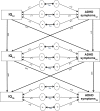A longitudinal twin study of the direction of effects between ADHD symptoms and IQ
- PMID: 25875897
- PMCID: PMC4398424
- DOI: 10.1371/journal.pone.0124357
A longitudinal twin study of the direction of effects between ADHD symptoms and IQ
Abstract
While the negative association between ADHD symptoms and IQ is well documented, our knowledge about the direction and aetiology of this association is limited. Here, we examine the association of ADHD symptoms with verbal and performance IQ longitudinally in a population-based sample of twins. In a population-based sample of 4,771 twin pairs, DSM-IV ADHD symptoms were obtained from the Conners' Parent Rating Scale-Revised. Verbal (vocabulary) and performance (Raven's Progressive Matrices) IQ were assessed online. ADHD symptom ratings and IQ scores were obtained at ages 12, 14 and 16 years. Making use of the genetic sensitivity and time-ordered nature of our data, we use a cross-lagged model to examine the direction of effects, while modelling the aetiologies of the association between ADHD symptoms with vocabulary and Raven's scores over time. Although time-specific aetiological influences emerged for each trait at ages 14 and 16 years, the aetiological factors involved in the association between ADHD symptoms and IQ were stable over time. ADHD symptoms and IQ scores significantly predicted each other over time. ADHD symptoms at age 12 years were a significantly stronger predictor of vocabulary and Raven's scores at age 14 years than vice versa, whereas no differential predictive effects emerged from age 14 to 16 years. The results suggest that ADHD symptoms may put adolescents at risk for decreased IQ scores. Persistent genetic influences seem to underlie the association of ADHD symptoms and IQ over time. Early intervention is likely to be key to reducing ADHD symptoms and the associated risk for lower IQ.
Conflict of interest statement
Figures



Similar articles
-
Co-occurrence of ADHD and low IQ has genetic origins.Am J Med Genet B Neuropsychiatr Genet. 2004 Jan 1;124B(1):41-7. doi: 10.1002/ajmg.b.20076. Am J Med Genet B Neuropsychiatr Genet. 2004. PMID: 14681911
-
Separation of genetic influences on attention deficit hyperactivity disorder symptoms and reaction time performance from those on IQ.Psychol Med. 2010 Jun;40(6):1027-37. doi: 10.1017/S003329170999119X. Epub 2009 Sep 15. Psychol Med. 2010. PMID: 19751540 Free PMC article.
-
A longitudinal twin study on the association between inattentive and hyperactive-impulsive ADHD symptoms.J Abnorm Child Psychol. 2011 Jul;39(5):623-32. doi: 10.1007/s10802-011-9513-7. J Abnorm Child Psychol. 2011. PMID: 21494861
-
Genetic and Environmental Influences on the Developmental Course of Attention-Deficit/Hyperactivity Disorder Symptoms From Childhood to Adolescence.JAMA Psychiatry. 2015 Jul;72(7):651-8. doi: 10.1001/jamapsychiatry.2015.0469. JAMA Psychiatry. 2015. PMID: 25945901 Free PMC article.
-
A twin study of attention-deficit/hyperactivity disorder dimensions rated by the strengths and weaknesses of ADHD-symptoms and normal-behavior (SWAN) scale.Biol Psychiatry. 2007 Mar 1;61(5):700-5. doi: 10.1016/j.biopsych.2006.04.040. Epub 2006 Sep 7. Biol Psychiatry. 2007. PMID: 16962074
Cited by
-
Neural substrates of self- and external-preoccupation: A voxel-based morphometry study.Brain Behav. 2019 Jun;9(6):e01267. doi: 10.1002/brb3.1267. Epub 2019 Apr 19. Brain Behav. 2019. PMID: 31004413 Free PMC article.
-
WISC-IV Intellectual Profiles in Korean Children and Adolescents with Attention Deficit/Hyperactivity Disorder.Psychiatry Investig. 2020 May;17(5):444-451. doi: 10.30773/pi.2019.0312. Epub 2020 Apr 24. Psychiatry Investig. 2020. PMID: 32321204 Free PMC article.
-
Performance of Autism Screening and Diagnostic Instruments Among Children with ADHD: A Systematic Review.J Autism Dev Disord. 2025 Jun 28. doi: 10.1007/s10803-025-06857-1. Online ahead of print. J Autism Dev Disord. 2025. PMID: 40580404 No abstract available.
-
Rethinking Intelligence Quotient Exclusion Criteria Practices in the Study of Attention Deficit Hyperactivity Disorder.Front Psychol. 2016 May 31;7:794. doi: 10.3389/fpsyg.2016.00794. eCollection 2016. Front Psychol. 2016. PMID: 27303350 Free PMC article. Review.
-
Cognitive, emotional, and social functioning of preschoolers with attention deficit hyperactivity problems.BMC Psychiatry. 2022 Feb 1;22(1):78. doi: 10.1186/s12888-021-03638-9. BMC Psychiatry. 2022. PMID: 35105343 Free PMC article.
References
-
- Kuntsi J, Eley TC, Taylor A, Hughes C, Asherson P, Caspi A, et al. Co-occurrence of ADHD and low IQ has genetic origins. Am J Med Genet. 2004, 124B: 41–47. - PubMed
-
- Frazier TW, Demaree H, Youngstrom E. Meta-analysis of intellectual and neuropsychological test performance in attention-deficit/hyperactivity disorder. Neuropsychology. 2004, 18: 543–555. - PubMed
Publication types
MeSH terms
Grants and funding
LinkOut - more resources
Full Text Sources
Other Literature Sources
Medical

